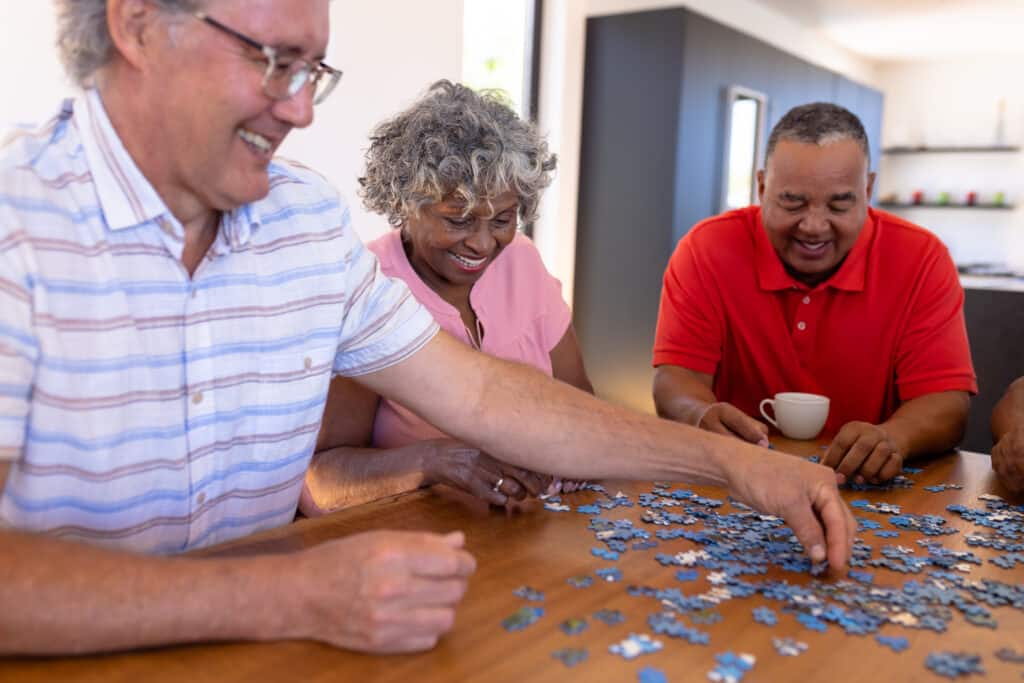When you think of exercise, you may think of typical forms such as running, cycling, or going to the gym. Exercise usually equates to training your body.
However, not many people realize the importance of training your brain. So let’s introduce you to some great cognitive exercise practices to illustrate why keeping your brain sharp is just as important as keeping your body fit.
What are cognitive exercises, and why should you do them?
Cognitive exercises —or brain training— are exercises in which you stimulate your brain. Instead of strengthening your muscles, these kinds of exercises strengthen your brain. In simple terms, this will help to keep your brain sharp.
Aside from improving your brain’s overall health, these exercises help improve various individual cognitive functions.
Our brains can become slower as we age, making cognitive exercises all the more critical as we go through life. Brain training can help improve concentration, memory, and reaction time.
But how can you keep your brain agile to stave off some age-related changes?
What kind of cognitive exercises are there?
Cognitive exercises come in many forms. When you think of brain training, you may think of complex activities or games that require you to think long and hard.
While memory, analytical, and logic games are all classic examples of cognitive exercise, many people do not realize that various simple, everyday tasks are also classified as cognitive exercise. You don’t always need to download an app or purchase sudoku puzzles to stimulate your brain.
Here are some examples of cognitive exercises that you can do daily. For many of these, you can use things that you may already have around the house. For some, you don’t need anything at all.
Try Dancing or Tai Chi

Everyone knows that dancing is a great cardio workout. However, it also serves as an effective way to stimulate your brain.
Learning new movements can be tricky. Dancing causes you to think and use your brain in a more creative way. It also improves your brain’s speed since you have to concentrate on quickly going from one movement to another.
There are numerous dance categories, almost too many to keep track of but all of them come with health benefits. Anything from Zumba and hip-hop to ballroom or line dancing makes for a great brain workout.
Build a Puzzle

Building a puzzle requires you to analyze different pieces and figure out how they go together. This is one of the best exercises to stimulate your brain since you must use both the right and left sides of your brain simultaneously.
The left side of your brain helps you think logically and analyze the pieces. The right side of your brain allows you to think creatively and see the picture as a whole.
Other benefits include stress relief and improvement of your short-term memory.
Play Cards—By Yourself or With Friends

Not only are card games loads of fun, but they also require a high level of concentration. Card games can improve your thinking and memory skills in a way that is fun and engaging. There are various games to choose from such as bridge, rummy, poker, and crazy eights.
Make sure to play with friends and family, you might even get a good laugh out of it (which is always great for your heart health, too).
If you are unable to play with friends and family, you can opt for some solo card games like Klondike and Solitaire. You can also download card games on your computer or smartphone, making setting up much easier.
Use Your Non-Dominant Hand

Using your non-dominant hand for daily tasks is an effective way to challenge and stimulate your brain. Whether right or left-handed, switching to your non-dominant hand for activities like writing, eating, or brushing your teeth forces your brain to work harder.
This engages brain areas not typically used, improving neural plasticity and coordination. Since these tasks often feel unnatural, your brain has to adapt by forming new connections, enhancing cognitive function.
Over time, this can improve focus, motor skills, and even hand-eye coordination, offering a simple yet powerful brain-boosting exercise.
Learn a New Language and Have a Conversation

Learning a new language requires a lot of remembering. You need to absorb a lot of information, practice it, and then remember everything you’ve learned.
Of course, learning a new language is probably one of the hardest things you can do, but it is for this reason that it is so beneficial to your brain.
It also gives you opportunities to practice your speaking and concentration skills. Practicing a language has been said to benefit those who suffer from dementia or Alzheimer’s.
Speaking two languages will help improve your brain’s ability to change from one task to another. Choose any language that you have always wanted to speak, whether you will use it often or not, and try and practice it for at least twenty minutes daily.
Take a Walk

Apart from its benefits for your body, walking can be very calming and promote a greater sense of independence.
People often say they will take a walk to clear their heads. This phrase has some truth to it since a good walk or hike can be physically and mentally rejuvenating. You may find that you feel more energized and that you can think more clearly after a walk on a beautiful day.
If you can, try to change your route regularly. Seeing new things and learning a new route will further stimulate your brain.
Meditation and Prayer

Much like walking, meditation and prayer offer significant mental and physical benefits, acting as therapeutic and rejuvenating practices.
While they are often viewed as passive or relaxing activities, they require a high degree of mental concentration and mindfulness. This focused attention during meditation or prayer helps improve cognitive functions such as attention and self-awareness, which can enhance overall mental clarity.
Meditation and prayer are also highly effective at reducing stress by activating the parasympathetic nervous system, which helps the body enter a state of rest and relaxation. This can lower cortisol levels, the hormone associated with stress, contributing to better overall health. Regular meditation and prayer have been shown to improve emotional regulation, making it easier to manage anxiety, depression, or frustration.
Moreover, these practices promote mindfulness, a state of being fully present and aware of the moment. This mindfulness can improve mental flexibility and resilience, helping individuals better cope with challenging situations.
Additionally, studies suggest that regular meditation can enhance brain plasticity, the brain’s ability to reorganize itself by forming new neural connections, which may slow cognitive decline in aging adults.
Recent research also indicates meditation and prayer can influence the brain’s pain perception. By altering the brain’s pain response pathways, individuals practicing meditation have been found to experience reduced sensitivity to pain, making it an effective tool for managing chronic pain conditions.
Listen to (or make!) Music

There are countless benefits to listening to music. It can reduce stress and anxiety, lower your blood pressure, and improve your memory—and, of course, it makes you feel good.
Listening to music is much more complicated for your brain than you think. Your brain needs to decipher between different notes and words even though all you are consciously doing is listening.
When you listen to the same music over some time, your brain will memorize it without you even thinking about it.
Making music also requires a lot of concentration and memorization, all while tapping into your creative side. If you already know how to play one or more instruments, practicing and learning new songs is an excellent workout for your brain.
If you don’t know how to play an instrument, it’s never too late to learn. You can take some lessons, or you can teach yourself.
Increase Your Vocabulary

If you are not interested in learning a new language, learning more about your native language can be just as beneficial.
If you come across words you do not know, write them down and look them up. Once you understand the meaning of a new word, try to write down a few sentences using this new word. This will help you understand the exact meaning of the word while ensuring you use it in the correct context.
Similar to learning a new language, improving your native vocabulary promotes your memory and concentration.
Are brain-training apps good for you?
App-based brain training games are challenging and have many of the same benefits as the activities listed above.
These games usually have categories in which you can choose which brain functions you want to improve. The games are also fun and can have some competitiveness to them.
However, they can become somewhat addictive and cause you to stare at a screen for an unhealthy amount of time.
If you enjoy these games but find they keep you occupied for long periods, try incorporating some exercises in the following video and divide your training time between different activities. A change in routine now and then can be beneficial to your brain.
Key Takeaways
- Cognitive exercises are essential for keeping your brain sharp and improving overall mental agility.
- Brain training helps to enhance important cognitive functions like memory, focus, and reaction time, especially as we age.
- Dancing is an excellent form of cognitive exercise, as learning new movements stimulates creativity and improves coordination.
- Puzzles engage both sides of the brain by requiring logical thinking and creativity, helping to improve problem-solving skills.
- Playing card games strengthens memory and concentration while providing a fun, social way to challenge your brain.
- Using your non-dominant hand for daily tasks forces the brain to adapt and form new neural connections, enhancing mental flexibility.
- Learning a new language involves memory, practice, and problem-solving, making it one of the most potent brain workouts.
- Regular walking benefits physical health and clears the mind, reducing stress and promoting cognitive clarity.
- Meditation and prayer require deep concentration and mental discipline, helping to calm the mind and improve focus.
- Listening to music engages different brain areas involved in memory, emotion, and cognitive processing, making it a beneficial mental activity.
- Playing a musical instrument challenges memory, coordination, and creativity, offering a full brain workout.
- Expanding your vocabulary by learning new words exercises memory and improves language skills, boosting cognitive function.
- Brain-training apps can be a convenient way to improve mental agility, but balancing screen time with other activities is important.
- Switching between different types of cognitive exercises helps prevent mental fatigue and keeps the brain engaged in multiple ways.
- Regular cognitive training can slow down cognitive decline, helping to maintain brain health as we age.
FAQs
What are cognitive exercises, and why are they important?
Cognitive exercises, also known as brain training, stimulate your brain and help improve mental functions like memory, concentration, and reaction time. They are important because they keep the brain sharp, especially as we age, slowing down cognitive decline.
How can cognitive exercises benefit older adults?
As we age, our brain may become slower, leading to memory loss or difficulty concentrating. Cognitive exercises help maintain brain health by improving mental agility, memory, and cognitive speed, promoting a better quality of life for older adults.
Can everyday activities be considered cognitive exercises?
Yes, many simple activities like doing puzzles, learning new dance steps, playing card games, and even using your non-dominant hand can be considered cognitive exercises. These activities stimulate both sides of the brain, improving mental function.
Is there a difference between learning a new language and improving vocabulary for cognitive health?
Both learning a new language and expanding your vocabulary in your native language are beneficial for cognitive health. Learning a new language requires intense memory work, while enhancing your vocabulary improves memory, concentration, and cognitive flexibility.
Are brain-training apps as effective as other cognitive exercises?
Brain-training apps can be effective and fun, offering targeted exercises for different cognitive functions. However, it’s essential to balance them with other activities like physical exercise, meditation, or social engagement to avoid spending too much time on screens and to stimulate the brain in different ways.
References
- Ball, K., Edwards, J. D., & Ross, L. A. (2007). The impact of speed of processing training on cognitive and everyday functions. The journals of gerontology. Series B, Psychological sciences and social sciences, 62 Spec No 1, 19–31. https://doi.org/10.1093/geronb/62.special_issue_1.19
- Lustig, C., Shah, P., Seidler, R., & Reuter-Lorenz, P. A. (2009). Aging, training, and the brain: a review and future directions. Neuropsychology review, 19(4), 504–522. https://doi.org/10.1007/s11065-009-9119-9
- Lampit, A., Hallock, H., & Valenzuela, M. (2014). Computerized cognitive training in cognitively healthy older adults: a systematic review and meta-analysis of effect modifiers. PLoS medicine, 11(11), e1001756. https://doi.org/10.1371/journal.pmed.1001756





